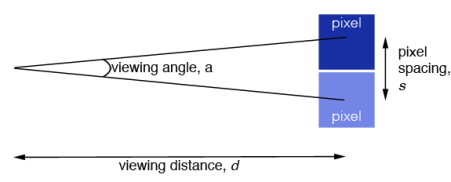 Apple’s Retina Display marketing broadly publicized the concept of retinal acuity, but each person’s vision differs; so, just how small do those pixels need to be for your vision?
Apple’s Retina Display marketing broadly publicized the concept of retinal acuity, but each person’s vision differs; so, just how small do those pixels need to be for your vision?
Fortunately, inverting the well known Snellen notation (e.g. 20/20 corrected vision, 20/30 uncorrected vision, etc…) gives your personal visual acuity in minutes of arc. For example, inverting 20/20 = 1 meaning that 20/20 vision can resolve 1 arc minute sized details. Similarly, someone with 20/60 vision has a visual acuity of 60/20 = 3.3 arc minutes; 20/15 vision can resolve 15/20 = 0.75 arc minutes. Go ahead and calculate your own visual acuity in arc minutes. Ready?
OK, let’s see how tiny the pixels on a screen need to be to make it a retina display for you. To do this, we’ll calculate the smallest pixels that you can resolve at a given distance. For example, if you have 20/20, or 1 arc minute, vision and hold a smartphone 11 inches (28 cm) away, you’ll be able to resolve individual pixels if there are 313 pixels per inch (123 pixels/cm) or fewer; if it has more pixels than that per inch/cm (i.e. higher pixel density & smaller pixels), then it’s a “retina display”.
Here’s how to calculate the minimum number of pixels per distance to match your eyes (fill in your visual resolution in place of “1“:
tan(½ × 1 arc minute) × 2 × 11 inches = 0.0032 inches (or the inverse of 313 pixels per inch (ppi) or more)
tan(½ × 1 arc minute) × 2 × 28 cm = 0.00814 cm (or 123 pixels per cm (ppcm) or more)
Spreadsheet formulas for this looks like:
<resolvable pixel> = tan(radians(0.5 * <your arc min.>/60)) * 2 * <distance>
<pixel density> = 1 / <resolvable pixel>
In more detail: to calculate the pixel size, s, opposite the viewer divide the angle, a, in half to give a right triangle with the viewing distance, d, adjacent to the angle and the length of ½ of a pixel opposite. 1 arc minute = 1/60 degree. Then with basic trigonometry:
tangent (angle) = opposite/adjacent
tangent (½ a) = ½ s/d
½ s = tan( ½ a ) d
s = tan( ½ a ) 2 d

If you were looking at a television 5-½ feet away instead, then you’d only be able to resolve 52 ppi (20 ppcm):
tan(½ × 1 arc minute) × 2 × 66 in. = 0.0192 in. or 52 ppi
tan(½ × 1 arc minute) × 2 × 170 cm = 0.0495 cm or 20 ppcm
A 42-inch diagonal, full HD television (1920×1080) also happens to have 52 pixels per inch; therefore, when viewed from 5-½ feet or farther the pixels begin to blur together for 20/20 vision. Homework: how close/far should you sit from your television to turn it into a “retina” display? Enjoy!
| Snellen acuity | Visual resolution (arc minutes) | Retina display, iPhone | Retina display, TV | ||
| (11 in, ppi) | (28cm, ppcm) | (9′, ppi) | (2.75m, ppcm) | ||
| 20/200 | 10 | 31 | 12 | 3 | 1 |
| 20/100 | 5 | 63 | 25 | 6 | 3 |
| 20/70 | 3.5 | 89 | 35 | 9 | 4 |
| 20/50 | 2.5 | 125 | 49 | 13 | 5 |
| 20/30 | 1.5 | 208 | 82 | 21 | 8 |
| 20/20 | 1 | 313 | 123 | 32 | 13 |
| 20/15 | 0.75 | 417 | 164 | 42 | 17 |